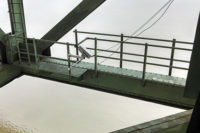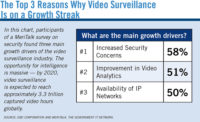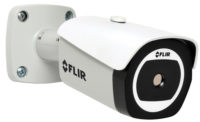The strengths of thermal cameras for use in video surveillance have been well-documented, most notably their reliance on heat signatures alone to “see.” All objects have a measurable temperature, and thermal cameras detect even slight differences among people, vehicles, backgrounds and more to generate video that highlights contrasts within a scene.
With thermal cameras, visible light isn’t necessary, bright light won’t distort images and weather or other harsh conditions can’t hinder their ability to capture usable video. Using the invisible heat radiation of each object in the field of view, these cameras can see what traditional cameras — and the human eye — cannot. And they can do this effectively over longer distances than their visible-light counterparts.
“When a human enters the camera’s field of view, even at long distances from the cameras, the security guard is able to detect an intrusion immediately,” says Brian Levy, CEO of Tehachapi, Calif. –based Hero Security and Surveillance, who also serves as a consultant for Pompano Beach, Fla.-based IC Realtime. “With standard color cameras this type of detection is much more difficult, since the contrast between the human and background may not be noticeable until the intruder is much closer to the camera.”
The availability of “entry-level” thermal cameras with fewer advanced capabilities at lower price points has led to increased adoption of the technology across a wider variety of customers and applications.
“The adoption of thermal cameras in mainstream security use has grown exponentially in just the past few years,” says Ron Grinfeld, global vertical marketing manager for FLIR Systems, Beaverton, Ore. “As capabilities expand and prices come down, they have been put to more and more innovative uses as security pros embrace this game-changing technology.”
The Sweet Spot
One other factor that hasn’t changed about thermal cameras is the primary reason they are deployed. While these cameras are increasingly being deployed in more creative applications (see “Non-Traditional Applications for Thermal Cameras” on page 144), detection is still their sweet spot — and remains the main reason most users choose thermal cameras in the first place.
“The thermal camera serves as the detector; that’s its primary purpose. In fact, we know of installations where the customer doesn’t even care about the video. They’re using the thermal camera to trigger into their intrusion system so that they can then send a guard to the location to investigate,” says Joel White, regional marketing manager, Bosch Security Systems, Fairport, N.Y.
This can also be helpful when someone is making a concerted effort to conceal their presence and movement.
“Using analytics, you can easily detect a person walking up to a fence and triggering alarms and have analytics track them. But when a person is rolling or crawling along the ground, you’re going to detect them but you won’t be able to identify that they’re a person because they’re not moving the way an analytic expect a person to move, which is upright and walking. But you will be able to see that they’re moving,” White says.
For these reasons, thermal cameras are ideal for outdoor locations where the goal is to detect that something is out of the ordinary, says Jerry Klapak, senior account manager for Burnsville, Minn.-based systems integrator VTI Security.
“One of the primary advantages we see with thermal cameras is they take all question and doubt out of the scene interpretation to determine if something fits or it doesn’t, or whether something belongs in the scene or it doesn’t,” Klapak says. “A thermal camera gives an immediate ability to assess a scene.”
Another benefit of thermal cameras is the ability to reduce the false alarms that tend to plague visible-light and IR-illuminated cameras, which can be fooled by shadows, blowing trees, animals and other factors.
“We use thermal cameras as a detection device in conjunction with our IP-based control panel, providing our central station operators with a real-time view and actionable clips of incidents in progress, thereby eliminating false alarms,” says Steve Spott, chief technology officer for Sonitrol New England, based in Rocky Hill, Conn.
Imaging Limitations
Like any technology, thermal cameras have their limitations. For starters, images may show the shape of people, vehicles or other objects but they can’t capture specific details. Another potential drawback is that the grayscale images these cameras generate aren’t always the easiest on the human eye. To overcome this, video from some cameras is presented with some sort of color.
“If ambient air temperature is 50 degrees, the camera will represent it as a blue color on the screen. If a human enters the scene and has a 98.6 temperature, then the camera will represent the heat coming off the body as red,” Levy says. “Hence there is an easy visual cue to alert the security guard to the fact that someone has entered the area.”
However, contrary to popular belief, these colors are more cosmetic than an accurate representation of actual temperatures within a scene.
“In some cases, you may see a thermal image that has color to it, but that color is not real. The color’s applied to a grayscale image to help the human eye distinguish between what effectively are shades of gray,” White describes. “Thermal cameras do not capture anything in color.”
Teaming up
The overwhelming majority of thermal cameras — even those producing colorized images — cannot resolve minute details within a scene, making them unsuitable for identification. For security purposes, identification is essential, which is why thermal cameras are combined with a conventional camera or PTZ, providing an early warning system that alerts the visible-light camera to capture the details necessary for apprehension and prosecution, for example.
“Thermal cameras should be used with other cameras to enhance early detection of intruders; this is their main strength from a security standpoint,” Levy says.
Another reason to pair thermal and standard cameras is the lower resolution of thermal imaging, which White says is very low considering what’s available in the visible-light market.
“Thermal in our industry is going to cap out at 640 x 480, which when you compare to standard cameras is like ancient times,” White says. “I can only imagine that the reasoning for that is that the sensors for the cameras would be so phenomenally expensive if they were larger that the government and satellites are probably the only ones who use those.”
These integrated applications rely heavily on video analytics, and despite their low resolution, thermal cameras actually provide excellent video for this purpose.
“Because they make images from tiny differences in heat, thermal cameras provide a naturally high-contrast video signal for video analytics, the computerized analysis of a video stream. Sophisticated software can recognize and isolate objects on a screen, such as an intruder climbing a fence,” Grinfeld says. “But to function best, video analytics needs to be able to distinguish the person on the fence from the background, which is why thermal contrast is so effective.”
Unlike standard, visible-light cameras, when used in conjunction with video analytics thermal cameras act as detection sensors that are capable of identifying distinct objects at distances of hundreds and even thousands of feet away.
“In one installation after another, thermal cameras coupled with thermal analytics have been field-proven to provide more efficient operation, fewer false or nuisance alarms, and easier alarm assessment, than any other technology in the industry,” Grinfeld says.
Plan, Plan, Plan
Regardless of the application, precise planning is the primary factor that will determine how successful a thermal camera deployment will be.
“Integrators have to spend a lot more time upfront planning. There’s a level of specialty here that’s more than just putting up another regular camera. There’s more of an investment here with thermal cameras,” says Anthony Incorvati, business development manager, critical infrastructure, for Axis Communications, located in Chelmsford, Mass. “The ones that perform better, you can just tell that there’s more time in the upfront design — GPS mapping, laying things out, using tools like CAD, really understanding the environment before placement and trying to optimize the area they’re trying to cover.”
Another reason planning is so important is that there can be a long period of time between ordering and receiving thermal cameras. The main culprit for this, White says, is that many of these cameras are covered by restrictions imposed by the U.S. Department of Commerce.
“It’s not like you can order one and get it tomorrow. In many cases, customers have to sign acknowledgement of the Department of Commerce paperwork declaring that they’re not going to export to banned countries or use it inappropriately, because the components of thermal imagers can be used for targeting and sighting and weapons,” he says. “The biggest message is think ahead. If you’re planning a project that’s going to use thermal, give yourself a good amount of time to get the camera in your hands.
Through the Looking Glass
At the heart of thermal cameras are thermal imagers and other technologies that combine to allow them to detect heat signatures that all objects generate. In addition, lenses are equally important in determining camera performance.
Thermal cameras cannot “see” through glass, rendering traditional lenses useless. For thermal solutions, lenses must be purpose-built with other materials, primarily germanium.
“Every thermal camera out there in our market is a fixed-lens camera, so integrators have to understand field of view and what they’re trying to accomplish, and pick the right camera and the right lens combination. They’re not interchangeable,” says Bosch Security’s Joel White. The lenses are built on the imaging module. I’ve seen some prototypes of varifocal thermal lenses but I can only imagine how expensive that is.”
Non-Traditional Applications for Thermal Cameras
Non-security stakeholders are starting to recognize the benefits of thermal cameras beyond simple detection. The technology can be applied to other functions, as VTI Security recently saw firsthand, says Jerry Klapak, a senior account manager for the integration firm.
In this particular application, there was a tank that needed to be refilled periodically within the camera’s field of view. The customer had relied on a sensor to determine when that tank needed to be topped off, but because that system was prone to failure, someone had to be sent out to manually check the level. So while the camera wasn’t purchased by the department responsible for monitoring and filling the tank, the department head has been very happy with this ancillary “beyond security” benefit.
“He’s not only received the benefit at this one location but he’s offered to subsidize cameras at other locations for the security department, as well,” Klapak says. “We’ve seen some good advantages in partnership and sharing of the information that thermal cameras provide.”
FLIR’s Ron Grinfeld says his company’s cameras have been deployed for a number of unique applications, including one customer in Switzerland who uses thermal imaging to detect shoplifters.
“Static objects have a different temperature than humans, which can be used to detect if a person is carrying a concealed object,” he says.
With machinery, electronics and other equipment, heat can be an indicator of potential breakdown or failure. For this reason, preventative maintenance is an emerging use for thermal cameras, particularly those based on thermography that can determine actual temperature levels, says Anthony Incorvati of Axis Communications.
“Thermals can detect which circuits on a switchboard are consuming more power or to find overheated substations or transformers. From a mechanical perspective, thermals are being used to monitor motors, pumps, and hydraulics systems to predict failures in advance,” he says. “This is not so much for security; it’s used more for industrial processes as a precursor to a fire alarm, so if something is starting to overheat, it will detect that.”
Understanding Reality
As with any solution, integrators face several challenges when working with thermal cameras. Most notable among these is the need to make sure end users fully understand the technology, specifically what it can and can’t do, says Jerry Klapak of VTI Security.
“A lot of people’s understanding of thermal cameras comes from watching the news, and they see a thermal camera in a helicopter that can zoom and follow or track individuals in combat-style situations,” he says. “There’s some limitation in terms of understanding that a thermal zooming camera is typically not in the price range for most of our clients.
“Most of the thermal cameras that we use have fixed lenses, so with that limitation it’s extremely important for us to get our design correct up front, not only in terms of the camera selection, but the placement,” he adds.
However, it’s not enough to simply set realistic expectations if you don’t get it in writing.
“You have to make sure they know what they’re getting and that they sign off on everything with the understanding of what they’re going to get out of their cameras,” Klapak says.
The Right Situation
In determining whether to deploy thermal cameras — whether in conjunction with traditional cameras or as a standalone solution — it’s important to consider their strengths and advantages compared with visible-light cameras. With this in mind, Ron Grinfeld of FLIR says thermal is a great choice for video applications where one or more of these factors apply:
-
Outdoor deployments in areas that aren’t well-lit 24/7 and where it’s impossible or impractical to add external illumination to a standard camera.
-
Situations where it’s important to be able to detect and track movement of people and/or vehicles approaching, penetrating or lingering in predefined perimeters and other areas.
-
Environments that experience harsh weather conditions.
-
Applications requiring the ability to detect objects at long distances.
-
Any surveillance application that focuses on situational awareness, as opposed to capturing details such as color, facial features, license plate details, etc.
MORE ONLINE
For more information about thermal video surveillance cameras and related topics, visit SDM’s website where you’ll find the following articles:
“How to Get the Most out of Thermal Cameras”
www.SDMmag.com/get-the-most-thermal-cameras
“Applications Heat up for Thermal Cameras”
www.SDMmag.com/applications-heat-up-for-thermal-cameras
“Security Solutions for Extreme Environments”
www.SDMmag.com/security-solutions-for-extreme
“Finding Profitability With Perimeter Video”
www.SDMmag.com/finding-profit-with-perimeter-video





